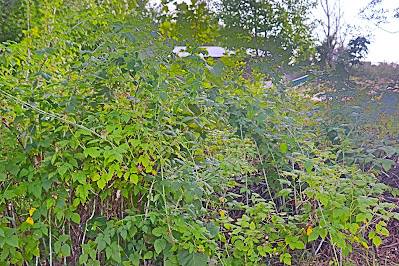 |
| Gardens in front of house |
 |
| Two cultivated apple trees |
Yes, I mow the areas immediately around my old farmhouse, and yes, I prune my two apple trees and this year thinned the too-bounteous crop, but lest anyone conclude that I have a "lawn" and "landscaping," here is the truth of my rural life: there is plenty of wildness all around me, in very close proximity. The yard area that I keep mowed is predominantly but not at all exclusively grass, any more than the meadow can any more be called (what it once was) a hayfield. All areas, mowed and unmowed, are thick with wildness. Here is a partial list of plants in my immediate environment, not in any seasonal order, but as many as I could put together from observation and memory:
In my yard, besides grass, there are: common plantain, dandelion, escaped oregano (drat!), heal-all, clovers, autumn olive (UGH!!!), mouse-ear chickweed, prostrate pigweed, hawkweed (both yellow and orange), pokeweed (one isolated colony), wild grape (too much!), poison ivy (could do without that!), lots of purple violets (love ‘em!), smaller pussytoes (very cute!), broad-leafed helleborine (a weedy orchid), prostrate pigweed, cleared, hoary alyssum, wood sorrel, purslane, purple dead nettle, and probably much more. If I were really ambitious, I would try to identify all the varieties of grasses. Maybe someday.
In my meadow grow: various native grasses (I seeded those years ago), common milkweed (tons!), coneflowers (purple and little grey-headed), asters (all sizes and colors of asters: I seeded the asters and coneflowers), red clover, sweet white clover, soapwort (a.k.a. bouncing bet) alfalfa (from former hayfield days), Queen Anne’s lace, wild roses, blackberries, goldenrod, bladder campion, evening lichnis, daisies, daisy fleabane, wild lettuce, goatsbeard, black-eyed Susans, spotted knapweed (ugh!), autumn olive (ugh! I'm doing as much as possible to eradicate, but it is everywhere in the county and well beyond), cow vetch, bull thistle (goldfinches love the seeds), chicory, curly dock, ragweed, St. Johnswort, red osiers, wild grape, Virginia creeper, white baneberry, evening primrose, and sapling trees -- silver maple, green ash, black walnut, catalpa, black willow, mulberry, box elder, and aspen (a.k.a. popple). Often in the morning my puppy and I notice places where deer have bedded overnight. Recently I have discovered two healthy hawthorns, and there may be more. If not now, there will be in future, I'm sure.
At edges and in crannies are found: spiderwort, black raspberries, red raspberries, gooseberries, wild ginger, escaped dayliles and poppies, black walnut seedlings (too many!), staghorn sumac, alfalfa (from that old hayfield), evening primrose, autumn olive (again!), poison ivy (again!), more violets (both purple and yellow), naturalized daffodils, jewelweed (both pale and orange), evening primrose, buttercups, lamb's quarters, broad-leafed dock, common burdock, common mallow, wild mint, Virginia creeper, wild grape, and more sapling trees (see meadow list above).
There is a single tulip poplar in the shelter of the old henhouse, and a companion redbud nestled close to the tulip tree for years but has since disappeared. Another redbud, however, has now appeared in the former popple grove, near one of the black raspberry patches. Everywhere, all is in constant flux, changes apparent year by year, so that my surroundings look very different from the way they looked 22 years ago, when we first began living here fulltime, and that look in turn (going back further in time) was very different from the way things were when we still lived in Leland but David had his studio and I my garden at the farm. A tall catalpa stands where no tree stood in our early days here, while the dead but standing popple (what Westerners call aspen) that housed a bluebird family for two summers is now only a memory. Just this evening I noticed once again a wild apple tree on the aft side of the barn, an uncultivated tree that fruits as it will, undisturbed by intervention from me. Here, as Grand Marais, Michigan says of itself, there is "Nature in Abundance," no antiseptic monoculture.
P.S. There are more photographs, some of them closeups, over on my photo blog now.










7 comments:
Wow, Pamela, I'm deeply impressed that you know SO MUCH about what grows on your land! As you say, there is probably much more, but you are very knowledgeable about the abundance surrounding you. Bravisima! We should all know way, way more than most of us do about our generous natural world.
Forever wild . How I love it .
Lovely pictures and interesting commentary about your wilderness. I loved: "Everywhere, all is in constant flux..." What a metaphor for life.
Karen, I took these shots with the HDR setting.
Interesting, Pamela. They are wonderful. I'm going to have to try that myself.
Thanks, Karen. I think I need more closeups of my wilderness, though. The daylily over on my photo blog was done with the same setting, and you can see how that color pops.
Laurie, there are at least two plants I have yet to identify. One I thought I knew, but I was wrong, and the other I can't find anywhere. I should post closeups of those!
Post a Comment